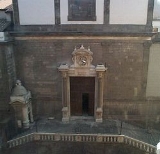
Santa Maria La Nova
Encyclopedia

Naples
Naples is a city in Southern Italy, situated on the country's west coast by the Gulf of Naples. Lying between two notable volcanic regions, Mount Vesuvius and the Phlegraean Fields, it is the capital of the region of Campania and of the province of Naples...
, southern Italy
Italy
Italy , officially the Italian Republic languages]] under the European Charter for Regional or Minority Languages. In each of these, Italy's official name is as follows:;;;;;;;;), is a unitary parliamentary republic in South-Central Europe. To the north it borders France, Switzerland, Austria and...
. It is located on the site given to the Franciscan order in 1279 when Charles of Anjou decided to build his Castel Nuovo
Castel Nuovo
Castel Nuovo , often called Maschio Angioino, is a medieval castle in the city of Naples, southern Italy. It is the main symbol of the architecture of the city...
(new castle), or Maschio Angioino, on the grounds of the order's original monastery, whence the name Nova ("new").
The "new" church was built in the late 13th century. The original Angevin building was removed in 1596 and a new structure was planned and built by Giovan Cola di Franco, with a Renaissance façade. The main altar is from 1633 and was designed by Cosimo Fanzago
Cosimo Fanzago
Cosimo Fanzago was an Italian architect and sculptor, generally considered the greatest such artist of the Baroque period in Naples, Italy.-Biography:...
. The church is located at the beginning of a side street directly across from the east side of the main post office.
The church contains a famous work of art: a 46-panel gilded fresco on the ceiling from 1600; it is the collective work of a number of artists, including Luca Giordano
Luca Giordano
Luca Giordano was an Italian late Baroque painter and printmaker in etching. Fluent and decorative, he worked successfully in Naples and Rome, Florence and Venice, before spending a decade in Spain....
. The church is a part of a larger monastic complex, much of which now houses municipal office space.

